Citi University, Mongolia
Abstract: In contemporary Inner Mongolian style orchestral music, the themes are mostly in the core tones of the pentatonic scale, and less in the changing tones. According to the characteristics of the theme and the aesthetic concepts, the harmonic technique mainly uses the traditional Western major and minor harmony, emphasizing the functionality and the logic of the chord progression. It uses the non-traditional harmony technique, emphasizing the pentatonic scale and the chord structure of the non-tertian chord. It also uses the traditional Mongolian polyphonic sustained tones, highlighting the variety of the sustained tones, and setting up the theme. The themes of contemporary Inner Mongolian orchestral music are melodic and the highlighting of the theme is the core of the composition. Therefore, the chord structure principles and the chord progressions become important polyphonic techniques for shaping the image of the theme and expressing the content of the theme.
Keywords: Inner Mongolia; Mongolian style; orchestral music; harmonic techniques
The contemporary Inner Mongolian orchestral music is based on pentatonic harmony, inheriting the traditional Mongolian polyphonic techniques, while borrowing and integrating the traditional Western harmonic system. In Mongolian orchestral compositions, the application of harmony is expressed in the principles of chord structure, chord progressions, and the support of sustained tones for thematic modulation and other polyphonic compositional techniques. This paper analyzes the use of Western traditional harmony, non-traditional harmony techniques, and the use of Mongolian traditional polyphonic sustained tone techniques.
1. The use of traditional Western harmonic techniques
Western traditional harmony is a functional harmony built based on the major and minor key systems. In contemporary Inner Mongolian orchestral compositions, the themes are built in pentatonic scale, with the five main tones of Gong, Shang, Jue, Zhi, and Yu as the core tones, and the changing tones such as Qing Jue, Run, and Bian Gong are rarely used. The five core tones are the stable tones in the pentatonic scale, which have the function of establishing the tonality of the tune, and are mostly used in the composition of strong beats, long tones, beginning and ending, etc., so as to establish the musical style of the pentatonic scale.The changing tones only play a colorful and decorative role in the construction of the theme and are less in number. In contemporary Inner Mongolian orchestral compositions, the use of Western traditional harmony is common. Since there is no distinction between core and changing tones in Western traditional harmony, the combination of Mongolian-style themes with Western traditional harmony varies according to the composer's creative concepts and orientation.
The first movement of Xin Huguang's "Grassland Suite", "Morning", is a single ternary form consisting of an introduction, ABA′, and coda, with the theme composed in pentatonic scale, and the introduction part of the work is entirely in the Western traditional harmonic method.
Example 1.The introduction to "Morning", the first movement of Xin Huguang's orchestral music "Grassland Suite".


"Morning", the first movement of the orchestral "Grassland Suite", has a four-bar introductory section that is composed in the Western harmonic tradition, with the main chord (T) and the genus chord (D) repeated in two primary triads. The cello and double bass play the bass with the root of the dominant chord and the genus chord, reflecting the functional progression of traditional harmony, while the violin and viola play the upper three voices in a triadic pattern, containing chord tones and a certain number of extra chord tones. The violin plays the uppermost part with a clear pentatonic tonal character. The introduction to "Morning" emphasizes both the pentatonic tonal character of the upper melody and the principle of functional progression of the dominant and genus chords in the Western harmonic tradition.
The traditional Western harmonic methods of major and minor keys are personalized according to the composer's aesthetic concepts in the theme of "Morning", the first movement of the orchestral "Grassland Suite".
Example 2.The theme of "Morning", the first movement of Xin Huguang's orchestral music "Grassland Suite".
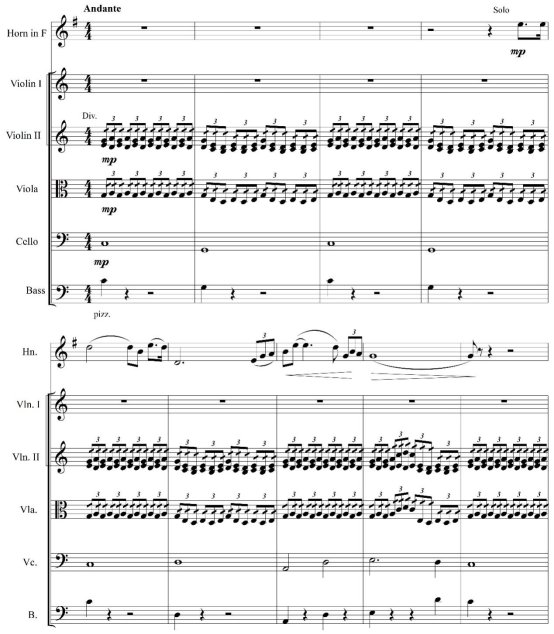
"Morning", the first movement of the orchestral "Grassland Suite", starts from the fifth bar, with the horn soloist playing the theme, which has a clear pentatonic tonal character, and the accompanying vocal pattern is an extension of the introductory part. In terms of the use of harmony, the composer uses the progression: T-D-TSVI7-SII-T-SII7-T, and the characteristics of traditional Western harmony are very clear. The theme of the first movement of the orchestral "Grassland Suite", "Morning", is built on the pentatonic modulation of the C Gong, while the harmony comes from the key of C major.
The use of harmonic structure in the orchestral "Grassland Suite" does not stop at the main and secondary chords of the key, but further uses off-key chords to make the harmonic color of the work more prominent.
Example 3.Bars 35-40 of "Morning" in Xin Huguang's orchestra music "Grassland Suite".

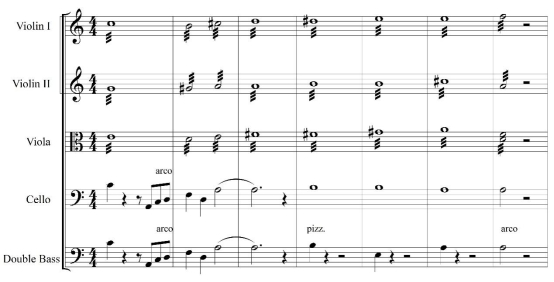
"Morning", the first movement of the orchestral "Grassland Suite", is an unfolding middle section, mainly in terms of thematic motive, tonality and harmony. The harmonic progression is mainly reflected in two aspects. Firstly, the three upper voices are advanced in the form of parallel chords, and the chromatic progression is emphasized horizontally, which has a tense effect. Secondly, the chords are used in a more perse way. In the second bar of example 3, the tone enters the key of A major and the chords are in the progression DⅦ7°-T-S-D/D-D-T. The use of the dominant seventh chord not only enhances the tension of the harmonic progression, but also shows the functional progression of the traditional harmony.
Example 4. Bars 76-79 of"Morning" in Xin Huguang's orchestra music "Grassland Suite".

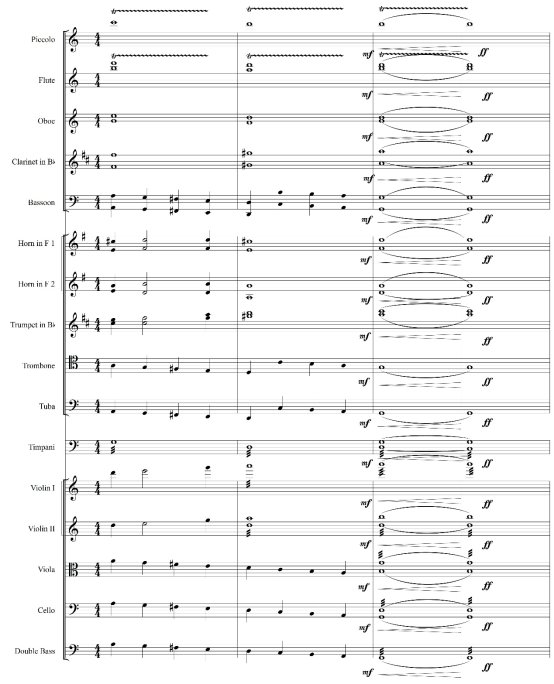
The last two chords of "Morning", the first movement of the orchestral music "Grassland Suite", are ended in D-T, clearly reflecting the typical functions and characteristics of the Western traditional harmonic termination.
The harmonic analysis of the introduction, theme, unfolding fragment and termination of "Morning", the first movement of Xin Huguang's "Grassland Suite", shows that the chord structure adopts the principle of the tertian chord, the harmonic progression emphasizes functionality and logic, and the beginning and termination reflect the characteristics of the Western traditional harmonic progression.
The theme of Yong Rubu's orchestra music "Gobi Camel Bells " is based on the mode of C Gong and a single part structure. Among them, the harmonic texture part of the previous sentence is completely carried out by using the three-dimensional overlapping chord structure of Western traditional harmonic thinking and the power of two-dimensional downward molding.
Example 5.The first phrase of theme II of Yong Rubu's orchestral music "Gobi Camel Bells".


The first phrase of theme II of Yong Rubu's orchestral "Gobi Camel Bells" presents the music score fragments of the horse headed fiddle and celesta. The theme of the horse headed fiddle performance adopts pentatonic scale, which has strong singing. The part of the celesta is the downward second degree of the arpeggio chord, which completely adopts the Western traditional chord structure and its methods.
To sum up, the following conclusions are drawn. Firstly, the traditional functional harmony in Western major and minor keys is based on the tertian chord as the chord composition, emphasizing the logic of the harmonic function. In contemporary Inner Mongolian orchestral music, many composers have borrowed the Western traditional harmonic methods of polyphonic composition. Secondly, the contemporary Inner Mongolian orchestral music mostly combines the theme of pentatonic scale with the traditional functional harmony of Western major and minor keys, expresses the artistic connotation of Mongolian music through the theme of pentatonic scale, and then combines the traditional functional harmony methods of Western major and minor keys, thus realizing the fusibility of polyphonic composition. Thirdly,the artistic relationship between traditional Western harmonic thinking and Inner Mongolian style themes has become one of the more characteristic polyphonic approaches of some composers in contemporary Inner Mongolian style orchestral compositions.
2. The use of non-traditional harmonic techniques
The chord structure of non-traditional harmony is not limited to the tertian chord. It is a compositional tool that incorporates a variety of structural methods based on highlighting pentatonic tonal themes. The combination of non-traditional harmony and pentatonic scale has compatibility and flexibility. The compatibility is reflected in the non-traditional harmonic structure of major second and minor seventh, perfect fourth and perfect fifth, compound structure, etc., which is very close to the tonal scale and is conducive to the harmony of vertical and horizontal combination. The flexibility is expressed in the fact that non-traditional harmony can adopt both the structure of the tertian chord and the structure of the non-tertian chord. For example, the "main chord" of C Gong mode can be composed of three core tones, which is the same as the structure of the main chord of C major, while the construction of "genus chords" of C Gong mode and C major mode is different. The genus chords in the C Gong mode can be composed of orthogonal tones: major second and perfect fourth combined with GAD; or perfect fourth and major second combined with GCD; or a mixture of orthogonal and partials: major third and minor third combined with GBD. The selection of chords in line with the aesthetic development according to the characteristics of the theme is a technique of adopting non-traditional harmonies in contemporary Inner Mongolian style orchestral music.
In contemporary Inner Mongolian style orchestral music, there are many works composed with non-traditional harmonies, and although the usage varies, the principle of the non-ternary form of chords is the same. The orchestral piece "Gobi Camel Bells" by Yong Rubu uses a lot of non-traditional harmony techniques.
Example 6.Theintroduction to Yong Rubu's orchestral music "Gobi Camel Bells".
![]()
![]()




In the introduction to the orchestral music "Gobi Camel Bells", the celesta and campane use chords in fourth and fifth respectively, accompanied by a triangle, to interpret the hopeful camel bells of life on the vast gobi. Firstly, the celesta starts with two sets of perfect fifths in acoustic decomposition, i.e. E-B and F-C, followed by a three-dimensional chord cycle of perfect fourth. Secondly, the campane also starts with a decomposition of augmented and diminished fourth and fifth, and after two bars it turns into alternating chords of perfect fourth and fifth, especially the chord structure of perfect fourth and fifth, creating an open and relaxed effect. The chord structure, especially the perfect fourth and fifth, creates an open and relaxing effect, and the chords use a lot of variations, so it is more in line with the mood expressed in the orchestral piece "Gobi Camel Bells ".
In the traditional harmony in Western major and minor keys, the problem of the seventh chord has to be solved during the progression or has certain progression requirements. In contemporary Inner Mongolian orchestral music, the chord progressions containing major second and minor seventh intervals have their progression characteristics and specific interpretations. Firstly, the major second and minor seventh are natural intervals in the pentatonic scale, so they are naturally compatible with the melody of the pentatonic scale. Secondly, the chord progressions containing major second and minor seventh intervals are pursued in a vertical acoustic way without considering the interpretation. Thirdly, the chord progressions containing major second and minor seventh intervals are arranged in a vertical aesthetic manner according to the characteristics of the theme.
Theme I of "Gobi Camel Bells" is in C Gong pentatonic scale. The singing theme is played by the horse headed fiddle, and the long tones, as well as the ornaments, are typical of Mongolian folk songs.
Example 7. Theme I of Yong Rubu's orchestral music "Gobi Camel Bells".




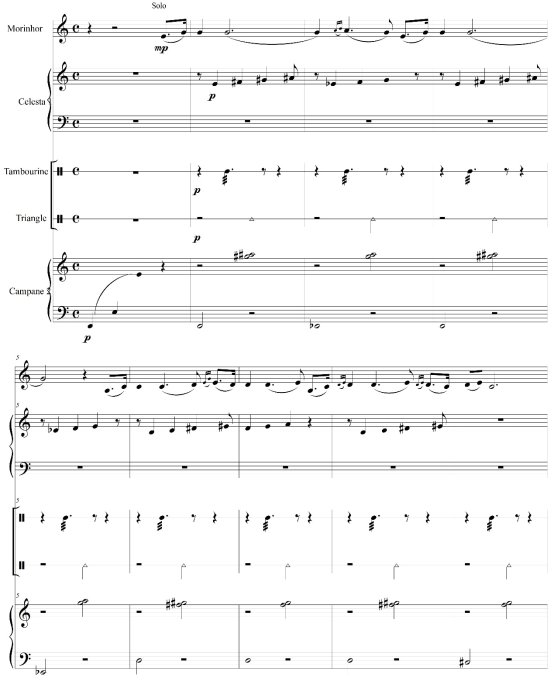
The partial score of theme I of "Gobi Camel Bells" shows that the orchestra adopts a folk song style theme, accompanied by the celesta using a major second upward progression of four tones alternating with three tones, with the characteristics of a full scale. The upper part is a succession of chords in a quarter note major second structure, with variations distributed among them, depicting the gobi camel bells, a fantastical picture unique to the Alashan region of Inner Mongolia. At the same time, the orchestral theme I of "Gobi Camel Bells" adopts the principle of non-traditional harmonic compound structure, i.e. the chord structure presents a combination of major second and perfect fourth or perfect fifth at the same time. In contemporary Inner Mongolian orchestral compositions, the composite structure is continuously used to enhance the vertical fullness of the work and the harmony with the theme, while highlighting the pentatonic tonal style of the work. It also shows the specific ways of using non-traditional harmonies in contemporary Inner Mongolian orchestral compositions.
Example 8.The last phrase of theme II of Yong Rubu's orchestral music "Gobi Camel Bells".


The last phrase of theme II of the orchestral "Gobi Camel Bells" is played by the horse headed fiddle. The theme is in the pentatonic scale of the C Gong, and the celesta plays the texture part, which is composed of perfect fourth and fifth as well as seconds and proceeds in succession to set up the theme.
In summary, the non-traditional harmonic use has the following characteristics. Firstly, it is premised on the polyphonic thinking embedded in the pentatonic tonal themes of contemporary Inner Mongolian orchestral music. Secondly, the chord structure is not bound to the principle ofternary form, and the chord progression is not restricted to the method of connection. Thirdly, based on the pentatonic tones, the use of other partial tones is not excluded.
3. The use of sustained tone techniques
In Mongolian traditional polyphonic music, there are a lot of sustained tone techniques, such as Khoomei, Chor, Huren Uligar, Horse headed Fiddle songs and Sanxian songs. The most typical feature of Mongolian traditional polyphonic sustained tone techniques is the sustaining of a single dominant tone, and there are also sustaining of other pentatonic tones and the combination of dominant and other tones in a double tone. The composition of contemporary Inner Mongolian orchestral music is based on the traditional Mongolian polyphonic music composition techniques, combined with the traditional Western major and minor harmony techniques of dominant and genus sustained tones, thus making its composition unique and rich.
The symphonic poem "The Song of the Erguna River" is titled after the Erguna River, the historical and legendary place where the Mongolian ancestors lived, and uses a lot of traditional Mongolian musical elements, such as a long melody in the style of a long-key pastoral, "nogura"-style ornamentation and the theme of the piece is a long melody in the style of a long pastoral song, with ornamental notes in the form of "nogura" and the spinning of fourth and fifth. In many places, the continuous sound composition is used, which highlights the characteristics of the Mongolian style polyphonic music of the symphonic poem "The Song of the Erguna River".
"The Song of the Erguna" begins in b-featured pentatonic scale, with the string section, except for the double bass, playing the theme in octave combination, with the harp playing the chords and the double bass playing the sustained tones.
Example 9.The beginning of Yong Rubu's symphonic poem "The Song of the Erguna River".



The theme of the symphonic poem "The Song of the Erguna River" has the typical rhythmic characteristics of a long and soothing Mongolian pastoral. The first two bars of the harp use a chord structure with major second, perfect fourth and perfect fifth decompositions, while the 4th and 5th bars are decomposed genus seven chords composed of the tertian chord. Sustained tones are used in the bass, where the dominant and the genus of the b Yu pentatonic scale appear one after the other, with a distinctive sustained tone character.
A similar sustained tone technique is found in the middle section of "The Song of the Erguna River", with a minor allegro theme in C Yu pentatonic tone, played by an oboe with the accompanying texture in the string section.
Example 10.Bars 50-54 of Yong Rubu's symphonic poem "The Song of the Erguna River".
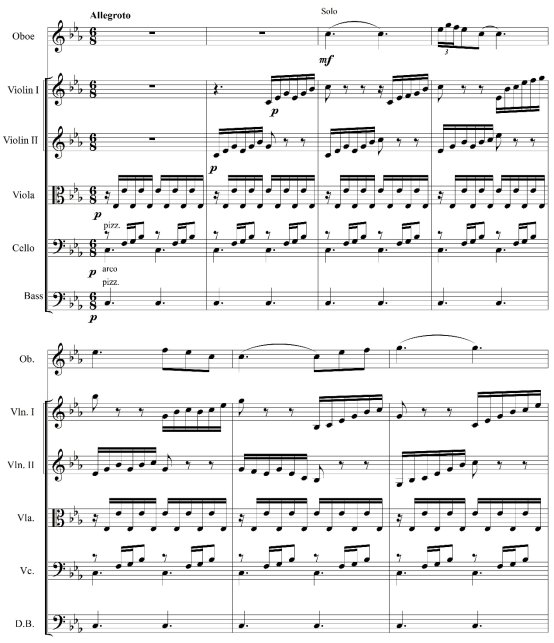
In example 10, all the string groups use the idea and technique of sustained tone composition. The double bass plays the sustained dominant. The cello is pided into two parts, the lower part is the dominant sustained, and the upper part is made up of the Shang, Jue and Zheng of the five tones. The viola is sustained by the octave of the Gong, and the first and second violins are disintegrated chords. The structure of the chords is both tertian chord and non-tertian chord, but all of them are integrated into the work using the technique of multiple sustains. All in all, the string section maintains the traditional form and morphological characteristics of sustained tones, but also innovatively constructs a three-dimensional, polyphonic form of sustained tones.
Contemporary Inner Mongolian orchestral compositions in the Mongolian style are more perse in their use of sustained tones to set up the theme while drawing on Western major and minor harmonies and non-traditional harmonies.
Example 11.The introduction to Yong Rubu's orchestral music "Gobi Camel Bells".
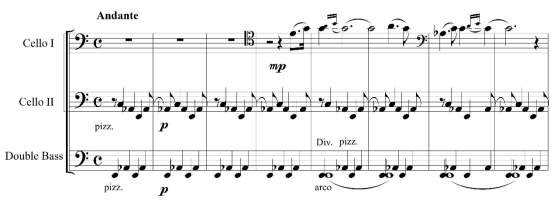
The theme of "Gobi Camel Bells" is built on the key of C-Gong. The low part of the introduction consists of C, E and A-flat tones using the sustaining technique, in which the E and A-flat tones are sustained in increasing fourth and decreasing fifth to create a silent, desolate and mysterious mood. The traditional Mongolian sustaining technique or the sustaining technique in Western traditional harmony mainly focuses on the main or genitive sustaining to enhance the stability of the tune. The use of the sustained tone technique in the introduction of "Gobi Camel Bells" is a breakthrough from the traditional sustained tone technique, and its use of increasing fourth and decreasing fifth is based on the consideration of the content of "Gobi Camel Bells ".
The analysis of the above-mentioned scores shows that there is a great deal of sustained tone thinking and techniques in contemporary Inner Mongolian orchestral compositions. At the same time, the sustained tone technique in the above examples has the same aesthetic thinking as the traditional Mongolian sustained tone technique, i.e., the main tone sustained thinking and technique are the norms, but the multi-voice sustained tone form is innovatively presented in various and three-dimensional ways. In Western traditional harmony, the main and genus sustained tones are used in the beginning, connection, preparation, recapitulation, and coda of work, while in contemporary Inner Mongolian orchestral music, the sustained tone technique is not limited by the height of the sustained tones and the parts of the piece, but is freely used in the work, playing the role of sustained tones to stabilize the key, set up the theme, and carry out the polyphony. It has a variety of functions.
4. Conclusion
The following conclusions can be drawn from an analysis of the use of Western traditional harmony, the use of non-traditional harmony, and the use of traditional Mongolian sustained tone composition techniques in contemporary Inner Mongolian orchestral music.
Firstly, the contemporary Inner Mongolian orchestral music is based on non-traditional harmony in pentatonic scale, featuring a mixture of non-tertian chord and tertian chord construction, and at the same time, borrowing and integrating the traditional Western functional harmony system based on the principle of tertian chord structure, and inheriting the traditional Mongolian polyphonic sustained tone technique.
Secondly, contemporary Inner Mongolian orchestral compositions are innovative in terms of chord structure, chord progressions, and sustained tone techniques. The method of chord structure varies according to the content of the theme, and the chord progressions shift freely between the principles of Western functional harmony and pentatonic scale in support of the theme. The sustaining methodhas the characteristics of being three-dimensional, polyphonic, and utilizing all tones while maintaining the main tone sustain as the basis.
Thirdly, the theme of contemporary Inner Mongolian style orchestral music, which consists of melodic and strong linear thinking, highlights the theme is the core of the composition, in which the chord structure and the method of chord progression become an important polyphonic technique for shaping the image of the theme and expressing the content of the theme.
In summary, the harmonic techniques of contemporary Inner Mongolian orchestral music have formed their style and artistic characteristics.
References
1. Fan Zuyin. A Harmonic Approach to the Structure of theTernary Form - One of the Studies on Pentatonic Tonal Harmony [J]. Journal of Zhejiang Arts Vocational College, 2003(2):36-51.
2. Fan Zuyin. An Introduction to Chinese Polyphonic Folk Songs [M]. People's Music Publishing House, 1994.
3. Fan Zuyin. Eighty Years of Harmonics Research in China[J]. People's Music, 2001(1):46-49.
4. Chao Lu. Harmonic Techniques in Mongolian Folk Polyphonic Music[J]. Journal of Inner Mongolia Arts College, 2011(2):36-41.
5. He Yibo and Song Shenggui. Aesthetics in Mongolian-style Symphonic Works[J]. Journal of Hebei University.2020(3):39-44.
6. Sang Jianliang. The Generation and Development of Mongolian Symphonic Music[J]. Music Research, 2007(1):122-124.
7. Jiang Hong. The Perfect Fusion of Original Mongolian Music and Symphonic Music-"Gadamerlin" Symphonic Poem[J]. Journal of the PLA Academy of Arts (Quarterly). 2013(2):22-24.
1